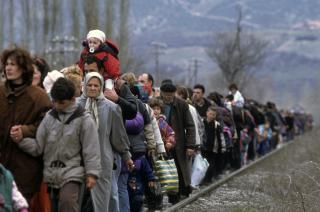Who is a refugee?
An international legal definition of the term ‘refugee’ and guidelines on how refugees should be treated and protected was first outlined in the UN’s 1951 Convention Relating to the Status of Refugees. It has since been signed by 147 countries. The Convention defines a refugee as someone, regardless of age, who is forced to flee their country and seeks protection in another country owing to:
“a well-founded fear of being persecuted for reasons of race, religion, nationality, membership of a particular social group or political opinion”.
The Convention was drawn up in response to the horrors of the Holocaust suffered in the Second World War and was initially limited to European refugees involved in events prior to 1951 making an application for refugee status. This definition was extended in 1967 to apply to a broader range of people subject to persecution of this kind.
Refugees should not be confused with:
Asylum seekers - When a refugee arrives in a new country, they are known as an asylum seeker until they are granted refugee status.
Internally Displaced People (IDP) - If someone has fled their home in fear of their life but has not crossed the borders of their country, they are known as an internally displaced person.
- By the end of 2008 there were nearly 42 million people who had been uprooted worldwide - 10.5 million were refugees and asylum seekers, and 14.5 million were IDPs.[1]
Why do people leave?
Refugees flee their homes to seek safety elsewhere. They are often driven out as a result of persecution, genocide and conflict. Genocide is a particularly severe form of persecution aimed at wiping out an entire ethnic, political or religious group. While conflict is one of the most significant factors, even during periods of apparent peace some groups or individuals in society may suffer religious, ethnic or political persecution which force them to leave the country.
A new factor which is being increasingly recognised is the impact of environmental disasters.
- Environmental refugees at present have no basis in international law, but natural and manmade disasters caused an estimated 25 million eco-refugees in 1998.[2]
Where do refugees come from and where do they go?
Although refugee movements spread across the globe, the overwhelming majority come from five developing countries:
- Almost half (45%) of all recognised refugees come from two sources: Afghanistan and Iraq. Completing the list of five leading sources of refugees are Somalia, Sudan, and the Democratic Republic of Congo.[3]
In the hope that they will one day be able to return, refugees tend not to go very far, with eight out of ten moving to a neighbouring country. The UK only hosts a small fraction of the refugee population.
- According to the UNHCR, the United Nations refugee agency, the vast majority (80%) of refugees are actually sheltering in the developing world, the poorest countries. The country hosting the most recognised refugees is Pakistan.
What are the challenges faced by refugees?
Refugees face a series of immediate needs and long-term challenges. Many refugees who survive the often treacherous journey find themselves in refugee camps and have seeking to satisfy their immediate needs like shelter, sustenance, security and sanitation. But there are additional risks.
- The cramped conditions in refugee camps mean that there is a high risk of infectious diseases being spread.
- Women and girls can be particularly vulnerable to abuse in mass displacement situations and subject to trafficking and sexual exploitation.[7]
Long term impacts
Even when if a refugee manages to reach another country and gains legal status, many challenges still remain.
- Some children miss out on education - estimates put the number of refugee children receiving education at no more than 30 %.[8]
- Since 2005, most people recognised as refugees are given permission to stay in the UK for five years only.[9]
What is the UN doing to help?
UNHCR, the United Nations refugee agency leads and coordinates international action for the world-wide protection of refugees and the resolution of refugee problems.
- When first created by the UN General Assembly in 1951, UNHCR was charged primarily with resettling 1.2 million European refugees left homeless in the aftermath of World War II.
- Now it is located in more than 110 countries it continues to help about 34 million persons.[10]

